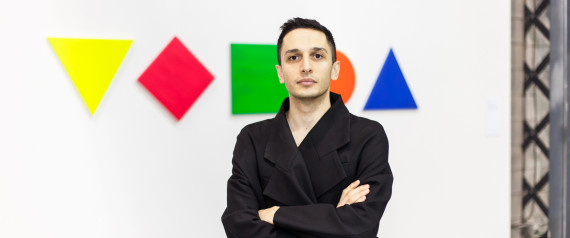Rad Hourani has no need to be humble. The 33-year-old fashion designer is an accomplished photographer, filmmaker, and is perhaps most notorious for his ‘invited member’ status within the world’s premier high fashion group, the Chambre Syndicale de la Haute Couture. Hourani’s style attempts to transcend the constructs used by humanity to categorize and order the world. Hence, ‘neutrality’: It’s an aesthetic Hourani claims had its genesis in his own lack of formal artistic instruction or, in his words, a “no-background background.”
Located in the interior of a repurposed warehouse, Neutralité is Hourani’s second and latest attempt at a multidisciplinary art exhibition. No variations in lighting are afforded within the space; illumination is equal throughout the exhibit, and coupled with the floor plan’s relative openness reflects the accessibility of Hourani’s artistic vision to all viewers. The rectangular trusses on the high ceiling recalls a wholesale retailer, with the many patrons adding to the cacophony of voices that dominate Neutralité’s soundscape. On any other night, however, the sheer vastness of the venue might be enough to intimidate patrons into silence.
First of the five segments comprising Neutralité is the Child’s Room. Setting the stage for following sections with works such as “Ageless”—a series of eight solidly-coloured pastel tableaus symbolizing the pure energy of life without social pressures—Hourani reveals a calculated minimalism as central to his neutral aesthetic. Such minimalism is, in fact, complemented quite well by the hollowed out industrial space and white palettes upon which many of the artist’s works are mounted.
As viewers move through the exhibit’s three middle sections, a multitude of pieces ranging from humanoid, rubber sculptures to brightly coloured, polygonal wood panels, and even a pile of sex toys are presented for the viewer. In displaying some 21 works of art, Hourani seems to actively take inventory of the many dogmas and precepts driving human socialization. Among these works are multi-tiered, aluminum daisies that display the inherently unbalanced interaction between socio-economic classes, and whose skeletal frames appear hollow, as if to indicate that the ideology of socio-economic stratification lacks substance.
Alongside each piece was an accompanying white placard printed with Hourani’s responses to his own work. Among these explanatory placards, there never seemed to be any suggestion for how exactly the artist would see his vision implemented—though perhaps this is left to the audience’s own imagination, or perhaps unimportant to Hourani’s work altogether.
Marking the final phase of the exhibit was The Adult’s Room. Here, the artist’s “Nationless” is practically a companion piece to his “Ageless”—both are sets of eight painted tableaus albeit with respectively darker and lighter shades. In addition to implying the transformation of child to adult, the two pieces help contextualize the collective entirety of Hourani’s works as being greater than the sum of its parts. Each piece is in itself lacking context when removed from Neutralité, just as Neutralité lacks clarity when judged without all of its constituent works.
Overall, the eclectic nature of the media and objects present in Neutralité—scattered within their vaguely partitioned sections—suggests that audience members are, in fact, walking through a manifestation of the artist’s own psyche. As the abstractions of the human mind often elude understanding, the definitive placards provide a guided tour through the artist’s reasoning and thoughts in a style akin to a written manifesto. Despite leaving little to the imagination, Hourani nonetheless offers the audience an intriguing view of his own blueprint for transcendental utopia.
Neutralité is located at Arsenal (2020 Rue William) and is running from Nov. 4 to Jan. 17. Admission is $10.









